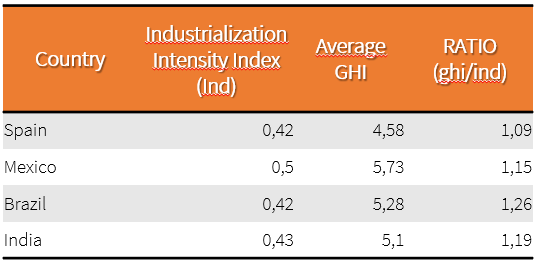Solar Energy: Developing a Strategic approach for SHIP Business in Spain
Solar thermal energy has been used in Spain for many years to provide hot water for residential and commercial applications. Flat plate and vacuum pipe collectors are a common sight in rooftops in Spain.
There is a relatively new and unknown technology provided by concentrating solar collectors that can provide higher temperatures of water and steam. This allows for solar thermal energy to be used as well in industrial applications.
Some projects for use of solar heat have already been developed in different industries in Spain, however there is an important potential for growth.
This document provides insight on the natural potential of Spain based on its combination of high solar radiation, industrialization, infrastructure, stability and EU´s road map towards a carbon free economy and it offers an engine for growth based on digital technologies.
Analyzing SHIP market conditions in Spain
- Solar Ratiation
From a solar radiation perspective, Spain is located strategically. It receives one of highest solar radiation levels in Europe and also competes well with the rest of the world.
According to the Global Solar Atlas, 75% of spanish territory receives more than 4.40 kWh/m^2 per day of Global Horizontal Radiation.

Six of the main industrialized areas of Spain and their corresponding GHI, based on the Adrase-Ciemat website.

More detailed information in the statistics below:

- Industry
Spain has is also an industrialized country, offering a good combination of solar radiation and industrialization.
The development of SHIP plants in Mexico in 2019 is remarkable. It is a success story and Spain has very similar conditions of solar radiation and industrialization.
Same thing if Spain is compared with four countries of SOLAR PAYACK Project India, Brazil, Mexico, and South Africa (The Solar Payback Project has the objective of promoting the use of solar industrial processes in its partner countries and it is funded by the IKI, German International Climate Initiative)
A simple ratio can be created by taking into account the average GHI (provided by the global world atlas) and the Industrialization Intensity index (provided by the world bank).

The solar radiation and industrialization level of Spain is comparable to Mexico’s.
MARATUM has started its assessment of potential manufacturers in Spain, a country with a large and very diversified industrial sector.
Starting with manufacturers that are able to use industrial heat under 400 C, the following screening process has been followed.

- Financial and technical infrastructure
Spain offers a solid infrastructure for engineering firms and manufacturers of concentrating solar collectors to find the necessary partners to develop their projects.
From the financial side there is a well established net of Energy Service Companies (ESCO).
From the technical side, there is not a shortage of firms that offer well trained installers for heating installations that can also carry out maintenance activities.
- Stable green future-The european green deal
As a member of the European Union, Spain offers stability and application of clear regulations.
The European Green Deal presented in December 2019 aims at making EU climate neutral by 2050, boosting the economy through green technology, creating sustainable industry and transport, cutting pollution.
Although many actions are still to be felt in the future, it will create a predictable business environment for industry and investors and will transform the Europeans economy for a sustainable future.
Understanding the challenge for SHIP companies.
With ideal market conditions and growing opportunities, SHIP companies need a plan to expand their business in Spain.
And as a plan we understand a methodological and solid approach that could be escalated and brought to any another country’s market.
We identify that the seller companies in the SHIP market have a diverse client base including leading brands or key accounts at different industries.
It is critical to develop a strategic approach based on a structured methodology, presenting the SHIP companies as strategic partners to their potential customers and at the same time bringing better energy solutions and business value to them.
Developing an approach for converting opportunities online
When 84% of marketers who measure return on investment tell you one marketing approach delivers higher returns than any other, you listen.
Especially when half of those people go on to describe the returns they’re achieving as ‘significantly higher’.
The approach in question is Account-Based Marketing (ABM) and it’s defined as ‘treating individual accounts as a market in their own right. ABM focuses the end-to-end marketing process on just one company.
In this Case Study we are going to position Account-based marketing as a business change initiative to drive SHIP companies’ growth.

ABM Guidelines
-
Determine the objective and strategy
The main goal of an ABM project is to generate more sales qualified leads and the strategy followed is educational.
Why educational?
-
- In order to generate awareness about SHIP technology and services as a new and successful option.
- In order to help our target discover the benefits of SHIP technology for their industries (energy cost reduction, fixed energy cost)
- In order to help our target trust SHIP technology and services.
- Finally, to facilitate the target contacts to get in touch with us.
In most of the cases a 3 months length cycle is enough to test the project and evaluate the first results.
During this cycle, the digital tools and software to build the infrastructure behind the project will be deployed and the content strategy and plan will be designed and implemented.
-
Align marketing & sales team – Identify the buyer persona
Both teams have to visualize this project as one that would conduct their efforts into generating more sales and therefore the company’s growth.
Together as one team they will begin by conducting extensive internal and external analysis to develop a comprehensive view of the customer’s behaviour.
What are their needs? What are their pain points? What are their common objections about the company’s products and SHIP solutions and what are their motivations for buying it?
This among other questions will determine the guidelines for the messages and the communications that will be sent.
-
Create a List Of Target Accounts
Creating a list of companies based on industry type (such as agriculture, textil, minery), company’s size and other segmentation criteria it’s relevant prioritizing our campaigns.
When creating this list we will take into account the buyer personas inside the companies, meaning that we will add to the list the decision makers we have to impact.
An organized process would require marketing working with sales to segment the account contacts into three groups: the decision makers; circle of influence; and operational teams.
Segmentation will allow us to create target account lists which we approach with the same personalized content and message.
-
Create campaigns to market to the target accounts
Once we have identify our potential customers we have to find the right way to attract them into our business.
The key components for executing the campaigns include a medium-term communications plan, teaching SHIP technology through education, building awareness, and using sales-enablement tactics.
Our goal is to reach the right people at the right accounts at the right time and using the right message according to each stage of their buyer’s journey.
-
Personalize the content for each target account
ABM has specific objectives and a narrow audience. It is, by definition, an integrated, coordinated programme of activities and content that proactively brings valuable propositions and relevant ideas to the potential client.
Convincing prospects to acquire a SHIP solution comes down to creating perceived value for your products and services.
People are not receptive to hard-sell messaging right away, so you have to guide them down a path that helps them feel engaged and helps them solve a key challenge or address an unfulfilled need. For example: reducing the fixed cost of energy or even get to know their real energy cost.
To lead them through this journey, we need to create attracting, engaging, relevant content. Having the right content allows us to stand out in a crowded marketplace.
Success cases, e-books, blog posts, case studies, videos are some types of content that are a fit for ABM campaigns.
-
Check campaign elements
Checking other elements besides the content is also important to assure we reach our campaign’s goal.
Assuring CTA is compelling and clear as long as the messages and links we send is the key to open doors in our buyer personas agenda.
We also want to check before the channel we will use to reach them.

-
Deliver Sales Qualified Leads to the Sales Team
Want to have your sales team busy? Thanks to a scoring system it is possible to deliver sales qualified leads to the sales team, as they focus into closing more deals.
-
Measure results
How do you measure success? For measuring ABM program impact, we will measure the full funnel, taking into account awareness metrics, funnel metrics and pipeline metrics so we can learn and adjust.
As an example, we care about measuring the follow metrics:
Opportunity based metrics:
-
- New revenue
- Pipeline growth
- Marketing-sourced new opportunities
- Opportunities in the pipeline







Deja tu comentario